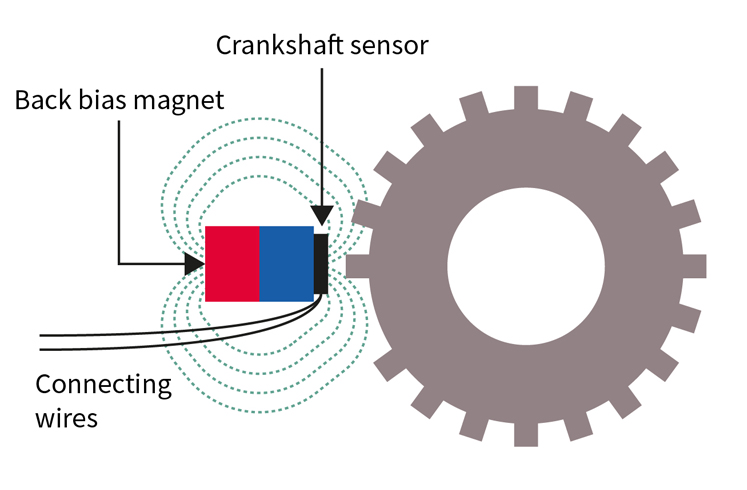By Klaus Grambichler, Senior Application Engineer, Infineon Technologies Austria AG

Klaus Grambichler, Senior Application Engineer, Infineon Technologies Austria AG
Sensors in combustion engines face special challenges in hybrid cars. Modern crankshaft sensors must differentiate between intentional rotation while the engine is running and random crankshaft movements, such as those caused by vibrations during purely electric driving. This is the only way, for example, to ensure a smooth transition when switching between combustion engine and electric motor. And only in this way can components such as the starter and the battery be dimensioned in the most cost-effective way. In this article Infineon describes corresponding algorithms in the latest XENSIV™ crankshaft sensor.
Car manufacturers across the globe are expanding their portfolio of drive systems. Even looking beyond the fuel cells and synthetic fuels of tomorrow, there is still a huge number of hybrid options spanning the gap between combustion engines and electric motors. These options range from stop-start combustion engines, where the motor shuts off for a few seconds at a red light and then does a cold start, to plug-in hybrids that can easily drive 50 kilometers in all-electric mode before the combustion engine kicks in as the battery runs low or the vehicle is travelling at high speed on a highway.
Two different implementations of even the most recent stop-start systems have already been brought to market. In one instance, the combustion engine starts again as if it had not been driven for an hour. The second solution monitors the movement of the engine as it comes to a stop, so when the engine starts up again, the car already knows the position of the crankshaft and the next cylinder to be fired.
If we look at the different positions where the starter generator may be attached to the drive shaft, or the points where the clutch connects different motors to the drive axle, we quickly see that the combustion crankshaft assembly options are virtually limitless.
Drive interplay as experienced by the driver
To maximize acceptance of new electric drive systems, manufacturers must win over former combustion enthusiasts with ease of operation and a predictable, smooth driving experience free of “nasty surprises”. It is important that a combustion engine can spring smoothly and almost imperceptibly into action – as already experienced at traffic lights or in traffic jams in start-stop mode. Here, it is essential that the car knows the angle of the crankshaft at all times. If the car stops for three minutes in a traffic jam, the crankshaft sensor is able to ignore a slight temperature drift or, ideally, compensate for it.
During a 30-minute drive on rough roads with a crankshaft that is free to move when decoupled from traction wheels, however, the sensor could incorrectly count a slight shake or vibration of a tooth or, in the worst case, interpret these movements as a new, valid signal. To ensure a combustion engine can glide into action, it is important that the sensor does not incorrectly count any of the teeth moving past it. It is imperative that the sensor does not miss any teeth, does not count any additional teeth, and does not mistake the rotational direction.
These criteria are broken down inside the crankshaft sensor as there is basically a magnet inside the sensor housing and the field lines of this magnet are modulated by the teeth as they spin past. As such, the sensor’s performance is ultimately determined by fluctuations in magnetic field strengths. And these are dependent on a number of factors including the air gap between the sensor and the trigger wheel and the temperature. To ensure we do not get sidetracked by the various mechanical and electrical details, this paper focuses primarily on the mechanical components that are relevant to the sensor’s performance.
The XENSIV™ TLE4929C crankshaft sensor family from Infineon has various functionalities that help to achieve the above-mentioned goal. The third generation of the sensor will be launched shortly. In addition to the already established stop-start algorithm and the algorithm for compensation of vibrations at standstill, it features a completely new hybrid algorithm.

The conventional stop-start algorithm
The “smallest” solution for reducing fuel consumption involves switching off the engine. It is already widely deployed and available as a conventional stop-start algorithm. This function is able to correctly interpret short stops in congested traffic or at red lights and can compensate for small temperature drifts.
Magnets are subject to very strong temperature drifts, which can change the magnetic field by up to 40 percent over the given temperature range. In the case of crankshafts with well-fitting bearings, the next most significant factor to impact sensor behavior is electrical in source. Number three in the lineup are changes in the air gap between the trigger wheel on the crankshaft and the sensor module on the engine block.
Ideally, the sensor remains fully calibrated and when the combustion engine starts again, it is able to correctly output the position and rotational direction of the crankshaft as soon as the first tooth of the trigger wheel spins past.
This functionality can be implemented without any modifications to the architecture of a combustion engine. All it requires is a slightly larger starter battery and starter motor and modifications to the software in the controller.
Figures 2 and 3 show how the disengaged crankshaft comes to a stop when the ignition is turned off as well as the quickest possible start for an Otto engine when compressed air is still in the cylinder (known as a direct start).

Vibrations while stationary
Modern cars carry out a range of self-diagnostic checks as soon as the driver’s door is opened. This reduces the amount of time it takes for a warning lamp to light up. A lot of other things can happen, however, from the moment the car door is opened to the time the car pulls away. The car can be loaded, for example, or children have to be buckled into their seats. As such, it is completely normal for the car to rock slightly while stationary. These slight movements travel through the drive wheels, transmission and clutch and cause the crankshaft trigger wheel to turn. In some unfortunate situations, this can result in the crankshaft sensor picking up a valid magnetic signal.

FIGURE 3 – Rotational behaviour of the crankshaft during direct start
To overcome this issue, an algorithm has been implemented in the Infineon sensor to delete calibration data generated before the engine is switched on.
If we take just a brief look at the wide range of hybrid architectures, it quickly becomes clear that this add-on function will help car manufacturers to identify and ignore any inaccurate calibration data.
As figure 4 shows, we can draw several conclusions from the sensor’s output signals over time. Firstly, we can see that the nominal rotational speed was not reached as soon as the sensor was activated. Consequently, the calibration data gathered up to the time where the nominal rotational speed was achieved can be reset without difficulty. Secondly, we see that this procedure can be repeated multiple times if the sensor does not identify a tooth for a certain period of time.

FIGURE 4 – Signal output of the crankshaft sensor when loading the car
Hybrid algorithm
A new function is required for a plug-in hybrid solution. To correctly identify the position of the crankshaft trigger wheel, an algorithm has been implemented in the sensor that detects slower, sub-nominal crankshaft rotation and, in conjunction with other monitoring functions, prevents incorrect calibrations. New calibration data is only accepted when the system is operating normally.
This function enables every crankshaft vibration to be captured with the corresponding signals for forward and backward movement without the crankshaft sensor incorrectly responding to supposed changes to the mechanical setup such as a shift in the air gap or some other mechanical misalignment.

FIGURE 5 – Signal output of the crankshaft sensor while driving in the hybrid module
Collectively, the algorithms named here enable the movements of the crankshaft trigger wheel to be accurately observed and tracked. The engine control unit knows at all times which stroke each piston is on and how much time is left until the next ignition (based on the crankshaft angle).
If the algorithms are correctly aligned, the system will operate correctly, ensuring that the engine warning light stays off.
Improved crankshaft sensor
As the crankshaft sensor always provides reliable information, the sizing of components required to restart the combustion engine can be reduced. The starter generator usually turns the crankshaft for several rotations until the home position of the crankshaft has been detected and a minimum rotational speed in excess of several hundred rotations has been reached.
With an advanced crankshaft sensor, the fuel can be injected and ignited in just half a rotation. Starting the engine in this way requires only a fraction of the battery energy needed for a cold start.
Manufacturers can thus choose between a longer service life for the starter and battery, or size down and save costs and weight, which – in turn – translates into a slight drop in consumption. This design also enables a great driving experience as the combustion engine starts easily and smoothly.
More precise switching points
Installed on the camshaft, the XENSIV™ TLE4929C can compensate for production and assembly tolerances on the supplier and manufacturer sides thanks to its programmable switching threshold. This ability means that this position sensor improves angle accuracy on both on the camshaft and the crankshaft.
First of all, it should be noted here that differential Hall sensors, by their very physical nature, only switch when the centerline of the tooth is in front of the sensor. Starting from the centerline of the tooth and moving out, the following tolerances must be taken into account:
- Mechanical tolerances on the tooth itself cause the magnetic center to deviate from the mechanical center
- Mechanical assembly tolerances for the module on the engine block account for the largest deviation
- Mechanical installation tolerances for the magnet and sensor in the module also have to be added
- It goes without saying that the installed magnets are not 100% homogenous; nor are they magnetized at a perfect 90° angle
- Finally, there are also electrical tolerances within certain limits that are attributable to the sensor manufacturer.
Systematic errors are compensated for by the engine control unit and are not included in the above list. They include signal propagation delays, which are already accounted for in the control unit’s timer.

FIGURE 6 – Breakdown of position errors
All of the components listed above result in a random error, which at best resolves itself but, at worst, can represent a massive fault. To meet the accuracy requirements of today’s systems, modern sensors allow switching thresholds to be individually set.
The module manufacturer can do this at relatively low cost by individually calibrating the switching point of the module at the end of the production process. It can also be done on the dry engine itself at a slightly higher cost.
The benefit for the car manufacturer here is that the calibration also compensates for their own production tolerances. In contrast, the tier 1 supplier can only compensate for the module itself; the OEM’s installation error is not mitigated at all.
Easy calibration procedure
At a mid-point in the switching threshold, suitable systems are used to measure the misalignment between the mechanical center of the tooth and the actual electrical edge. After this, the systematic errors are subtracted and the remaining offset is programed and permanently stored in the sensor as the programmable switching threshold.
As shown in figure 6, this method can be used to eliminate nearly all sources of error and improve the overall accuracy from +/-0.6° camshaft to +/-0.1° camshaft.
Summary
The combustion engine has had its day. From 2020 to 2025, all major car manufacturers worldwide will develop and launch their last hybrid platforms. After this, even the last remaining development engineers working on combustion engines and possibly also transmissions will have to find a new home in the emerging fields of fuel cell, battery and electric drive technologies.
The combustion engines developed today will be around for several decades to come. As such, it is vital that the technology used in these models is reliable, long-lasting, and up to date. Luckily, the challenges that hybrid engines and, in particular, crankshaft and camshaft sensors face in these systems are already known and being successfully addressed by Infineon.
Overview of Infineon XENSIV™ crankshaft sensors
- TLE4929C-XAx First-generation low-jitter, Hall-based crankshaft sensor.
- TLE4929C-XVA Second generation includes several further crankshaft protocols (by number 14) and a time watchdog to overcome start-up vibrations. In addition, this device is available with nickel plating for the first time.
- TLE4929C-XHA Third generation includes an additional dedicated hybrid watchdog and a new calibration feature to meet increased absolute phase accuracy requirements.





